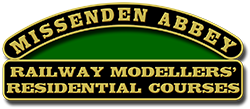Paul Bambrick - Backscenes & Scenics
 With an interest in the Metropolitan Railway and a much needed break from American dragsters, Paul returned to railway modelling a few years ago with Whitchurch Road, an exercise in 7mm. He was a studio illustrator at the time and wanted to see what could be done with a backscene project to blend with the scenery. For a several years now, he has been taking commissions to undertake similar projects on other layouts, notably Kevin Wilson’s Bucks Hill. Paul has been invited to demonstrate at several exhibitions including Guildex and Railex, and taken introduction and advanced backscene workshop classes at Pendon Museum. Some of the content has now been adapted into an illustrated book for Ian Allan Publishing, but Paul’s natural habitat is always hands on work, so you can either bring your project along, or do a test panel with Paul to build your confidence.
With an interest in the Metropolitan Railway and a much needed break from American dragsters, Paul returned to railway modelling a few years ago with Whitchurch Road, an exercise in 7mm. He was a studio illustrator at the time and wanted to see what could be done with a backscene project to blend with the scenery. For a several years now, he has been taking commissions to undertake similar projects on other layouts, notably Kevin Wilson’s Bucks Hill. Paul has been invited to demonstrate at several exhibitions including Guildex and Railex, and taken introduction and advanced backscene workshop classes at Pendon Museum. Some of the content has now been adapted into an illustrated book for Ian Allan Publishing, but Paul’s natural habitat is always hands on work, so you can either bring your project along, or do a test panel with Paul to build your confidence.
 Backscenes[/caption]
Backscenes[/caption]
Paul has a website: bambrickstudio.co.uk. He also features a page on that site that describes how his weekend course is organised.
Tim Watson – Advanced Locomotive Chassis Construction
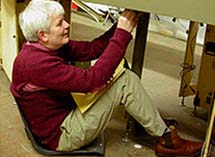 Tim Watson is President of the Model Railway Club and pictured here working on their 2mm layout Copenhagen Fields.
Tim Watson is President of the Model Railway Club and pictured here working on their 2mm layout Copenhagen Fields.
Tim started railway modelling many years ago. He changed to N gauge in 1971 and subsequently moved to 2mm finescale in the early 1980’s. He was involved with two Model Railway Club layouts ‘Chiltern Green & Luton Hoo’ and over the last quarter century ‘Copenhagen Fields’. Tim scratch builds locos in 2mm scale but enjoys all aspects of railway modelling, especially creating an artistic representation of an area.’
Copenhagen Fields is the subject of a “Right Track” dvd “The Right Track to Copenhagen Fields”.
During the Covid 19 pandemic Tim presented the contents of his lockdown workbench in our Spring 2021 virtual weekend. The recording of that presentation is available on the website. It is split into three sections, each with a distinct project.
- Building a 2mm Great Central Valour locomotive for Copenhagen Fields
- A Lynton & Barnstaple project
- The York Road Underground extension for Copenhagen Fields
Mick Moignard – DCC Sound
 Mick Moignard has been modelling seriously since teenage, mostly working the 3-foot gauge lines of southwest Colorado, the Denver and Rio Grande Western and Rio Grande Southern in HO scale. That has led to scratch and kit-building building of rolling stock and the detailing of far-eastern brass locomotives, as RTR Colorado models are rather thin on the ground. Adoption of DCC, in Mick’s opinion one of the best things to have happened to the hobby – has led to much improved operation of the models and now, with the use of high-quality sound decoders, properly set up, the overall image is greatly enhanced. He is still employed in the computing world as a software developer but building up a “retirement” business as a DCC installer, specialising in sound.
Mick Moignard has been modelling seriously since teenage, mostly working the 3-foot gauge lines of southwest Colorado, the Denver and Rio Grande Western and Rio Grande Southern in HO scale. That has led to scratch and kit-building building of rolling stock and the detailing of far-eastern brass locomotives, as RTR Colorado models are rather thin on the ground. Adoption of DCC, in Mick’s opinion one of the best things to have happened to the hobby – has led to much improved operation of the models and now, with the use of high-quality sound decoders, properly set up, the overall image is greatly enhanced. He is still employed in the computing world as a software developer but building up a “retirement” business as a DCC installer, specialising in sound.
As an NMRA member, Mick has embraced the ‘Sharing Know-How’ philosophy, writing many magazine articles and giving clinics at NMRA and other conventions here and in the USA. Older readers may remember a series on HOn3 rolling stock in Continental Modeller in the 90s, or a long series on DCC in ScaleFour News in the 2000s; that set of articles is still available as a download from Mick’s blog pages. On the strength of those articles, Mick now has the NMRA Authors Achievement Program certificate to go with his Master Builder, Cars, and several Merit Awards for locomotives. He has also won a number of convention contest placings, again, both in the UK and in the USA.
As well as having a home layout in HOn3, for some years Mick and a modeling friend had an On30 layout on the exhibition scene: Parsons Lumber Company, Camp 93, This, now retired after over 50 shows, was one of the very first layouts on the circuit to feature DCC and sound, and using DCC to the full, no fixed control panel either, with the entire layout operated from the DCC throttles.
Andrew Thompson – Weathering
 Andrew Thompson has had a lifelong interest in railways, with a particular emphasis on steam power which was heavily influenced by a childhood in South Africa surrounded by working steam locomotives. Other than the usual childhood model railway his first “real” layout was built whilst working at sea and occupied the perimeter of his cabin which is where his interest in weathering began. After being dissatisfied with his unguided first attempts, he booked himself onto a course at Missenden Abbey to gain knowledge and techniques from experienced tutors where he gained confidence to experiment and develop his own style. Although mainly interested in US railroads, due to the vast variety of rolling stock and prototype photos, an occasional British subject makes it to his work bench. Examples of Andrew’s weathering work, along with reference photographs can be seen on his Flickr account. Andrew recorded two videos for our virtual events during the Covid 19 pandemic
Andrew Thompson has had a lifelong interest in railways, with a particular emphasis on steam power which was heavily influenced by a childhood in South Africa surrounded by working steam locomotives. Other than the usual childhood model railway his first “real” layout was built whilst working at sea and occupied the perimeter of his cabin which is where his interest in weathering began. After being dissatisfied with his unguided first attempts, he booked himself onto a course at Missenden Abbey to gain knowledge and techniques from experienced tutors where he gained confidence to experiment and develop his own style. Although mainly interested in US railroads, due to the vast variety of rolling stock and prototype photos, an occasional British subject makes it to his work bench. Examples of Andrew’s weathering work, along with reference photographs can be seen on his Flickr account. Andrew recorded two videos for our virtual events during the Covid 19 pandemic
Ian Morton – Layout Wiring
 Ian spent much of his working life in the computer industry beginning as a field service engineer when microcomputers (as they were then) were just starting to be taken into business use, then moving on to training, support and programming. Redundancy saw him move to Midland Counties, the Ian Allan mail-order booksellers producing catalogues and advertisements. Employed to describe the books for the catalogue meant that he could often be found drinking a cup of tea with his feet up whilst reading a book, possibly the perfect job! The closure of Midland Counties led to another career change and he became a professional layout builder, a business that has somehow morphed into a small model shop.
Ian spent much of his working life in the computer industry beginning as a field service engineer when microcomputers (as they were then) were just starting to be taken into business use, then moving on to training, support and programming. Redundancy saw him move to Midland Counties, the Ian Allan mail-order booksellers producing catalogues and advertisements. Employed to describe the books for the catalogue meant that he could often be found drinking a cup of tea with his feet up whilst reading a book, possibly the perfect job! The closure of Midland Counties led to another career change and he became a professional layout builder, a business that has somehow morphed into a small model shop.
He has been a railway modeller since he was knee high to a grasshopper when he received a Märklin train set. The integrated signals, point control and automation gave him an early grounding in model railway electrics. Over the years, he has modelled in N, OO, OO9 and O gauge but the first layout that he actually completed was one serialised in Hornby Magazine. He wrote many articles on electrics and DCC for the magazine in its early years along with several books for Ian Allan Publishing including: Aspects of Modelling: Railway Electrics, Aspects of Modelling: Digital Command Control and Digital Command Control: The Definitive Guide.
Ian presented two Right Track videos: ‘Starting on the Right Track‘ and ‘No.12 Wiring Your Layout‘. Content from that later of these is available in our virtual weekend.
Mike Bolton – Advanced Train & Layout Control
 A Lancastrian, Mike has a natural instinct for all things mechanical or electrical making all sorts of models from an early age and acquiring his first electric train set at the age of 8. He built a valve radio in primary school, ‘scratch building’ track and locos in his early teens because he couldn’t afford to buy anything RTR. Modelling was a mix of aircraft, boats and railways with radio and hi-fi construction till completing a four year ‘sandwich course’ at Liverpool Poly. in Electrical Engineering. When he moved to Edinburgh for his first post-grad. job, modelling was put on the ‘back burner’. A Ph.D in Bio-medical Engineering at Strathclyde University was followed by political activity, marriage and two children, along with a career as a lecturer in Aberdeen University.
A Lancastrian, Mike has a natural instinct for all things mechanical or electrical making all sorts of models from an early age and acquiring his first electric train set at the age of 8. He built a valve radio in primary school, ‘scratch building’ track and locos in his early teens because he couldn’t afford to buy anything RTR. Modelling was a mix of aircraft, boats and railways with radio and hi-fi construction till completing a four year ‘sandwich course’ at Liverpool Poly. in Electrical Engineering. When he moved to Edinburgh for his first post-grad. job, modelling was put on the ‘back burner’. A Ph.D in Bio-medical Engineering at Strathclyde University was followed by political activity, marriage and two children, along with a career as a lecturer in Aberdeen University.
When his son was 7 he re-kindled Mike’s interest in Railway Modelling and they started a new layout in the loft. Mike’s son moved on to other activities, but his own research (now in Manchester) involved the design of miniature electronics in the medical field. Mike realised he could apply this knowledge to Model Railways; at the same time DCC was becoming popular and the NMRA had produced the DCC Standards. Mike’s modelling interest is American HO and he became a NMRA member, was co-opted onto the NMRA DCC Working Group and joined MERG about the same time. Since then he has developed many circuits which have became MERG kits. Mike was also using the CAN bus in medical equipment and, with others, applied this to model railways in the form of ‘CBUS’ – a general purpose layout control system using just a two wire ‘bus’.
Mike retired in 2006 and model railway electronics has become an almost full time activity. He has tutored at Missenden on the Electronics for Railway Modellers courses for a number of years and thoroughly enjoyed it.
Jerry Clifford – Locomotive Construction & Structure Modelling
 Jerry, born in 1964, has been interested in railways, and modelling them, for as long as he can remember. On leaving school he trained as a wood machinist and spent a number of years making reproduction furniture. He returned to education in 1990 as a lecturer in History at Bath Spa University before returning to the tools in the early noughties. Jerry now earns a living as a professional model maker as well as writing for the model press. He is one of the guest editors for Model Railway Journal. He is currently working on a book, ‘Railways in the Landscape; Modelling in the 2mm Scales’, for Wild Swan, due out soon.
Jerry, born in 1964, has been interested in railways, and modelling them, for as long as he can remember. On leaving school he trained as a wood machinist and spent a number of years making reproduction furniture. He returned to education in 1990 as a lecturer in History at Bath Spa University before returning to the tools in the early noughties. Jerry now earns a living as a professional model maker as well as writing for the model press. He is one of the guest editors for Model Railway Journal. He is currently working on a book, ‘Railways in the Landscape; Modelling in the 2mm Scales’, for Wild Swan, due out soon.
Building to commission has given him experience of a wide range of scales and prototypes but his personal modelling has always been in 2mm finescale. With a wide range of interests including the Colonel Stephens lines and the Western Region of his youth, his first love has always been the Somerset and Dorset and Midland, particularly pre-1930. He is slowly building Bath Queensquare at home but can regularly be seen on the exhibition circuit with his wife Kim either demonstrating or with one of their layouts, Highbury Colliery, Tucking Mill, William Smith’s Wharf or Foxcote New Pit.
Jerry hosted a locomotive building question and answer session during our Autumn 2020 Virtual Weekend event, a recording of that session is available on the website. During our Spring 2021 Virtual weekend Jerry presented his approach to designing and building layouts, with particular focus on Tucking Mill. The recording of that presentation is available on the website also.
Peter Brownlow DCC, CBUS & Computer Control
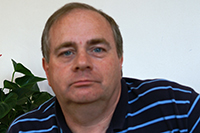 Pete is a software engineer by trade. He started in the early 80’s with Texas Instruments programming the same type of micro controller chip that was used in the first Zero 1 decoders. He now runs his own small IT consultancy business.
Pete is a software engineer by trade. He started in the early 80’s with Texas Instruments programming the same type of micro controller chip that was used in the first Zero 1 decoders. He now runs his own small IT consultancy business.
He has always been interested in railways, unfortunately just young enough not to remember the end of steam. His interest started when his Dad took him on the Brighton Belle as a toddler and with the OO gauge layout that was at home. In his teens during the 70’s he was a member of Brighton MRC, meeting at London Road Station, Brighton.
Other aspects of life took priority and Pete did not rediscover railway modelling until he was in his forties. A raid of the loft at the parents house recovered much of the childhood OO gauge locos and stock, so being sentimental and unwilling to throw anything away, that is now Pete’s scale and gauge.
Pete joined the Model Electronic Railway Group (MERG) in 2004 which provides a nice amalgamation of the interests in electronics and model railways. He is currently part of the MERG team developing the firmware for the new MERG DCC system and is also the co-ordinator for the MERG East Midlands area group.
Pete also did live sessions for us at our virtual weekend events during the Covid 19 pandemic, recordings of these are available on this site.
Barry Norman – Scenery & Baseboards

Barry first took a layout, Wyndlesham Cove, to an exhibition in 1977. It won the Railway Modeller Cup in 1981 and its popularity led to Barry writing articles in Railway Modeller. Some film work also followed which showed his passion for making scenery.
His second layout, Petherick, led to his first book ‘Landscape Modelling’ which was a best seller published by Wild Swan and more than 60 articles have appeared in Model Railway Journal. Some of these articles covered layout design and led to his second book ‘Layout Design’.
Barry took the photographs for his first book and has since photographed numerous layouts by many modellers who have influenced the hobby. His photographs have appeared regularly in Model Railway Journal.
Further layouts – ‘Lydham Heath’ and ‘Inkerman Street’ – followed with more articles and photographs and although he occasionally exhibits, he is increasingly asked to demonstrate his skills in making scenery. He also gives talks and has travelled as far as New Zealand and Australia.
He has returned to film in the ‘Right Track’ 5 & 6 ‘Modelling Landscapes’. The contents of these DVD is available in the scenery room of our virtual weekend.
Steve Duckworth – 4mm Locomotive & Kit Construction
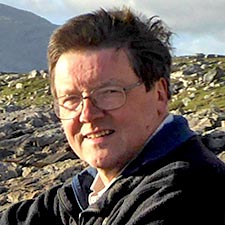 Steve has been involved in railway modelling since he started playing with dad’s old Hornby O gauge, between the legs of grandma’s grand piano in her music room. His own clockwork set came in c1959, followed by the 00 Dublo ‘Talisman’ at Christmas 1961.
Steve has been involved in railway modelling since he started playing with dad’s old Hornby O gauge, between the legs of grandma’s grand piano in her music room. His own clockwork set came in c1959, followed by the 00 Dublo ‘Talisman’ at Christmas 1961.
An early devotee of Jenkinson and Essery, his LMS 1930s Settle and Carlisle interests of teenage years moved to MR era West Riding Lines after a University hiatus in the early 1970s, all in 00, finally settling on early 1920s S&DJR – specifically Radstock – in P4 in 1981. The decision reflects strong family roots in Somerset and Dorset, though it was made whilst living in Glasgow! The Midland railway remains a strong secondary interest, another familial loyalty, having had a great-grandfather engine driver at Stourton shed, Leeds.
After a varied ‘career’ as geologist, metallurgist and industrial archaeologist, for the last nine years Steve’s ‘day job’ has been building 4mm scale engines to commission in 00, EM or P4 gauges, first for John Brighton’s ‘Steamline Sheffield’ and since 2013, on his own account. He is now retired from commissions and concentrating on his own S&D stud, both from kits and scratchbuilds. He has had wide experience of building compensated and different types of sprung chassis, as well as ‘solid’ types; he learns something new every day in this game.
Ian Rathbone – Painting & Lining
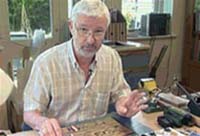
Ian is probably one of the best known professional model painters. He is also very well known for passing on his knowledge to others in the form of talks, courses, demonstrations at most of the principal exhibitions and the written word.
Although not a prolific author, his first article, on the construction of a North Stafford tank engine appeared in Model Railways in 1992; a major supplement to British Railway Modelling on painting and lining appeared in 1999, and was reprinted in 2001. Other articles have appeared in Model Railway Journal. His main work has been ‘A Modeller’s Guide to Painting and Lining’, published by Wild Swan, which has become the definitive work on the subject. He presents, along with Tony Wright, the Right Track No. 3 – Painting, Lining & Finishing. The contents of this DVD is available in our Painting & Lining room of our virtual weekend.
A retired Civil Engineer, his modelling career followed the normal pattern from Hornby clockwork through Trix, Hornby Dublo on Wrenn flexible track, to the finescale work he does now. He has been painting for about 30 years, the last 16 professionally. He has a detailed knowledge of railway liveries & especially those of the steam period of British Railways. He can build a chassis and solder too.
See Ian’s website: Ian Rathbone – Model Railway Painter
Gordon Ashton – Templot
 I am a retired Customs Officer of some 42years service, who has spent time in a variety of disciplines in the department, but not VAT.
I am a retired Customs Officer of some 42years service, who has spent time in a variety of disciplines in the department, but not VAT.
My last few years was spent arresting people, seizing duty free cigarettes, tobacco and spirits along with the vehicles that were transporting the aforementioned goods.
My retirement consists of model railways, some time at the AVR and Millie my short wheel base Land Rover.
My modelling background is P4 with previous forays into EM, 3mm, N-gauge, starting with 00. I have been building and designing my own point and crossing work for at least ten years using Templot.
I have not been involved with the main line companies but have been an active volunteer on the Avon Valley Railway. With this railway I was firstly trained as a driver of our 5 ton steam crane and through this skill spent quite a bit of time working with our track gang. This also involved laying new track and point work and learning how various bits went together.
I also worked my way up to driver on the steam side but have had to stand down due to health problems, but am still involved with some crane driving.
Chris Hopper – Weathering
 Chris has had a life-long fascination with railways both model and prototype.
Chris has had a life-long fascination with railways both model and prototype.
He has a wide range of modelling interests and has built a number of exhibition layouts which have featured in the model press including Pixash Lane (4mm BR); Bakewell Street (7mm BR); Gilbert Junction (3.5mm US) and Gare de Brindille (16mm WDLR).
Chris has been a participant in the Weathering Course at Missenden for a number of years and has benefitted enormously from the knowledge and expertise of former Missenden tutors Tim Shackleton and Mick Bonwick.
He recently described his experience in a short article for the Missenden 2020 Virtual Autumn weekend and has a Flickr album of his work, click here to view.
Kevin Wilson – 7mm Locomotive & Kit Construction
 Kevin came to model railways and the 7mm arena in the early 1990’s, via the tried and tested baby boom route of model boats (pre radio control, round the pole hydroplanes) and aircraft, radio controlled slope soarers and scale gliders. The latter became so large and expensive that a cheaper option was full size gliding! All the kits were sold to fund the purchase and I was left looking for another modelling challenge This presented itself during a chance visit to the West end and a look around the IMREX show, I was fascinated by what was available in 7mm.
Kevin came to model railways and the 7mm arena in the early 1990’s, via the tried and tested baby boom route of model boats (pre radio control, round the pole hydroplanes) and aircraft, radio controlled slope soarers and scale gliders. The latter became so large and expensive that a cheaper option was full size gliding! All the kits were sold to fund the purchase and I was left looking for another modelling challenge This presented itself during a chance visit to the West end and a look around the IMREX show, I was fascinated by what was available in 7mm.
A move from South London to Hertfordshire provided the space to consider a 7mm layout and inspired by “Holiday Haunts”, work began with Watford club colleagues on a new project, “Bucks Hill” The layout had it’s first outing to Telford in 2006, and in common of layouts of this size it is still a ‘work in progress’.
Bucks Hill, and the rolling stock required, gave the perfect excuse to build locos ad nauseam, and early retirement from work in the city has accelerated the pace of both the layout and the locos!
Justin Newitt – CAD Tutor
 Justin has been interested in model railways since picking up a copy of the Railway Modeller in Tesco’s Hereford store in March 1989. After early teenage dabbling in OO and OO9 he has been modelling in P4 since his early twenties. His interests mainly cover South and Mid Wales along with the Welsh Marches, where he grew up, around the end of steam. Being born in 1979 he never got the chance to see this but if a time machine did exist then it would be used to take him back to the 1960s and the lineside at somewhere like Pengam Sidings on the edge of Cardiff or Worcester Sidings in Hereford to watch the trains.
Justin has been interested in model railways since picking up a copy of the Railway Modeller in Tesco’s Hereford store in March 1989. After early teenage dabbling in OO and OO9 he has been modelling in P4 since his early twenties. His interests mainly cover South and Mid Wales along with the Welsh Marches, where he grew up, around the end of steam. Being born in 1979 he never got the chance to see this but if a time machine did exist then it would be used to take him back to the 1960s and the lineside at somewhere like Pengam Sidings on the edge of Cardiff or Worcester Sidings in Hereford to watch the trains.
In 2013 Justin set up Rumney Models after starting to produce some of his own etches and has been a semi-professional model maker and kit designer since leaving his previous career in 2016. As well as selling the fruits of his own modelling interest he also undertakes commission work for others, either building his own etched kits or producing artwork for etching and 3D printing. What time that isn’t spent in the world of model railways is spent looking after his young daughter. Justin has professional qualifications in both Autodesk’s AutoCAD (2D) and Inventor (3D) and enjoys nothing more than using these types of tools to produce new models.
Karl Crowther
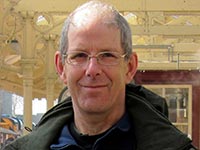 Karl has been a keen railway modeller since his early teens, working mainly in 4mm scale, EM gauge. His first major exhibition layout “Kentside”, set in 1960s South Cumbria, appeared at 34 exhibitions and was featured in issue 103 of the Model Railway Journal. He turned ‘professional’ around 2012 and has amassed a wide portfolio of projects including locomotives and rolling stock, signalling, plus buildings in both 4mm and 7mm scales.
Karl has been a keen railway modeller since his early teens, working mainly in 4mm scale, EM gauge. His first major exhibition layout “Kentside”, set in 1960s South Cumbria, appeared at 34 exhibitions and was featured in issue 103 of the Model Railway Journal. He turned ‘professional’ around 2012 and has amassed a wide portfolio of projects including locomotives and rolling stock, signalling, plus buildings in both 4mm and 7mm scales.
In recent years Karl has worked closely with Brian Lewis of Timber Tracks in his production of laser-cut building kits, where Karl offers an assembly and painting service. A major project was the construction of the “Castle Cross” train shed for John Ryan’s 7mm scale layout “Over Peover”. Experience of laser-cutting techniques has been put to good use on Karl’s latest layout project that is currently on the exhibition circuit – “Hebble Vale Goods”, a 1970s West Yorkshire shunting diorama.
Writing widely in the railway modelling press, Karl has contributing material to the Model Railway Journal, for whom he is now a guest editor, as well as the Railway Modeller and British Railway Modelling magazines.
Tony Gee – 4mm Locomotive & Kit Construction
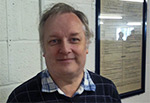
Tony was born in 1960 and has been involved with model railways for most of those years. His father was a model railway enthusiast; Tony’s Christening present was a Hornby Dublo set. Always interested in making models Tony made his first attempts at scratchbuilding locos when he was about 10 years old.
When he was 18 his interest became more serious and he joined the local club which had a large EM gauge section and ever since has been involved with a large number of layout projects, the latest of which is the reconstruction and restoration of the late Peter Denny’s Buckingham Branch.
Many of layouts Tony has been involved with have appeared in the modelling press over the years, including Tickhill & Wadworth, Narrow Road, Thompson’s End and Retford.
When Tony was “between jobs” a few years ago, people offered him money to build models for them and, almost by accident, he became a professional model builder. Although his own interests centre around the Great Central Railway in EM gauge in pre grouping times, he has constructed models in various gauges and scales and has a wide experience of building locomotives from whitemetal and etched brass kits as well as scratchbuilding.
Norman Solomon – Track Construction

Norman has been modelling professionally for 35 years building all sorts of layouts. He specialised in track building when he realised that little consideration was being given to real scale track. He has written many articles is various Railway Modelling magazines.
At Missenden Abbey, Norman’s track laying group has people who are just starting, others with a little bit of experience and those working on more advanced projects and who just need a bit of guidance.
Norman presents Right Track 10 Laying Terrific Track in which he demonstrates the way he constructs and lays track. The content of the DVD is however available in the Track room of our virtual weekend.
John Gowers – Electronic Control For Novices
 John started modelling railways in 1959 when he was given a Hornby Dublo three rail train set whose locos he still runs although now converted to two rail with DCC [Digital Command Control] sound. He also models in 00, 009, 0 and G gauge.
John started modelling railways in 1959 when he was given a Hornby Dublo three rail train set whose locos he still runs although now converted to two rail with DCC [Digital Command Control] sound. He also models in 00, 009, 0 and G gauge.
Interest in the control of his railway using DCC began about 10 years ago when John attended a Missenden Modellers weekend. His G gauge garden railway uses the MERG [Model Railway Electronics Group] DCC and CBUS systems [it also has radio controlled live steam]. John also has an extensive 00 gauge layout which uses both MERG and the Digitrax systems but which originally was DC [Direct Current] CAB controlled. Current work involves upgrading a large 0 gauge Club based exhibition layout, changing it from ZTC to MERG CBUS and DCC.
John has converted more than 80 locos to DCC many of which are sound fitted including a Wickham trolley in 4mm and an ex 3 rail Hornby Dublo West Country. He regularly runs soldering workshops, helps with problem solving electronics and tutoring, for two local MERG groups as well as demonstrating at Model Railway exhibitions. With Peter Brownlow,John has designed and built several bespoke PCB’s [Printed Circuit Boards] to add electronic control to various aspects of model railways including wire free control panels.
Along the way I have encountered many pitfalls and have learnt from the experience in fact I can safely state that I am still learning! I look forward to being part of your railway modelling journey.
John presented two soldering demonstrations as part of our virtual weekend events during the Covid 19 pandemic, recordings of these are available on the website.
